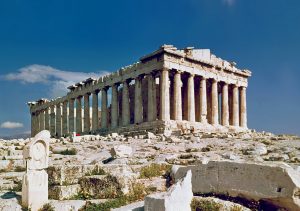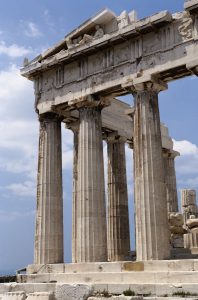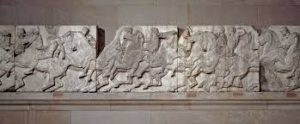Today we went through the earliest forms of communication in human history, looking back at the cave paintings, hieroglyphs, and Chiaku-Wen. I was most surprised by the way humans adapted, created, and translated our writing systems. My group’s focus during this time period was architecture, specifically the Parthenon.

The Parthenon is recognized as the architectural symbol of Ancient Greece. Located on the Acropolis of Athens, the Parthenon was built by the Athenians in 447 BCE and completed in 432 BCE. It was created as a temple dedicated to the goddess Athena Parthenos.
The most notable aspects of the Parthenon are the columns and friezes. The columns of the Parthenon follow the Doric order. The Doric order was the first and simplest style of Classical Greek architecture. These massive columns are fluted, baseless, and topped with a square slab. The silhouette of the columns curves outwards in the middle, this was done to remove the optical illusion that occurs when the column appears narrow in the center even if its proportions are equal to the top and bottom. There are 8 columns on the east and west ends of the Parthenon along with 17 columns on the north and south sides.

The Parthenon frieze is an Ionic order high-relief sculpture. The Ionic order was the second style of Classical Greek architecture and was used mainly for small temples and interiors. The frieze is located in the inner chamber of the temple, also known as the cella, and was made purely for decorative purposes. This contrasts the simplicity of the Doric order, creating a harmony between simple and intricate details. The Parthenon’s style of architecture integrates both the Doric and Ionic Order. Combining two forms of architecture was a rare practice in Ancient Greece, however the result gave the Parthenon an iconic look, making it a world monument.

Citations:
Harper, A. (2016). Parthenon. In Facts on File (Ed.), World history: a comprehensive reference set. New York, NY: Facts On File. Retrieved from https://ezproxy.capilanou.ca/login?url=https://search.credoreference.com/content/entry/fofworld/parthenon/0?institutionId=6884
Parthenon. (2017). In Encyclopaedia Britannica, Britannica concise encyclopedia. Chicago, IL: Britannica Digital Learning. Retrieved from https://ezproxy.capilanou.ca/login?url=https://search.credoreference.com/content/entry/ebconcise/parthenon/0?institutionId=6884